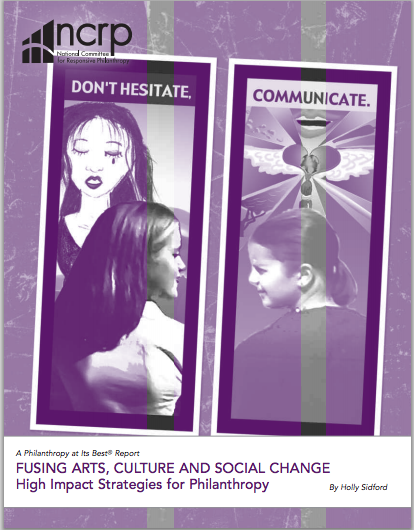This is a skin-and-bones summary of my full Arts Policy Library write up. Head that way for a much more thorough and nuanced discussion of “Fusing.”
Holly Sidford’s “Fusing Arts, Culture and Social Change: High Impact Strategies for Philanthropy” calls for a major overhaul in arts philanthropy in the United States. It argues that arts philanthropy, as currently structured, perpetuates inequality across the arts and culture sector by disproportionately funding large institutions that focus on Western European traditions. The report cites a number of present-day factors that make the case for change all the more pressing, including:
- The changing racial and ethnic composition of the United States and widening gap between the rich and poor
- artists breaking new ground in finding ways to apply the arts toward social justice goals
- inherent inequities in organizations’ access to private and public capital, with the largest 2% of organizations receiving 55% of all gifts, grants and contributions
The report does an excellent job of calling attention to organizations doing compelling work with arts and social change, and raises important questions about entrenched inequities in arts philanthropy. Unfortunately, it does not provide a clear vision of how funders should redistribute their resources, in large part because it conflates different segments of the arts sector (i.e. organizations pursuing social justice, small arts organizations, culturally-specific organizations, and individual artists) and fails to acknowledge varying levels of quality and impact within these categories. This problem and others manifest in ways including:
- A misleading interpretation of income inequality among arts organizations. Without considering what large organizations’ budgets are used for, it seems premature to conclude that funding a large organization perpetuates inequity. Furthermore, although the 55%/2% statistic has often been cited by those reading the report as evidence of foundations’ lack of attention to smaller organizations, it refers not just to foundation grants but also to contributions and gifts from individuals. Essentially, all it tells us is that some organizations have larger budgets than others.
- Lack of evidence that small and mid-sized organizations can better advance social change than large ones. By virtue of their broad reach, large organizations may represent an attractive return on investment to funders seeking to reach a large audience in a short amount of time. Many large institutions represent a variety of cultures, provide free or reduced priced events, and offer targeted outreach activities.
- Lack of articulated need for funding. “Fusing” states that artists, tradition bearers, and culturally-specific organizations are already rising in number due to demographic shifts, but doesn’t specifically address what additional role private philanthropy should play in that process. Should foundations support these artists and organizations to continue doing what they’re doing or ask that they expand or shift their scope?
None of the issues undermine the assertion that inequities exist within the arts sector, but they do raise questions about the extent to which those inequities are problematic, and whether they are problematic for the same reasons that the report identifies.
Where “Fusing” does succeed is in compelling us to think more deeply about how and when the basic notion of equity informs arts funding. Private funders can, as “Fusing” suggests, seek out and learn from the higher-quality work undertaken by arts and social change organizations, and support systems for our field to become more thoughtful in exploring and documenting the impact of arts. They can also fund third-party research to study both the intended and unexpected consequences of arts programming in underserved communities. We could use a better understanding of how newer, more grassroots organizations evolve as they expand their scale and scope. These organizations may not now operate under a “classic model,” but the models they do offer seem like fertile testing grounds for better understanding not just the impact of artist-activism, but the impact of private grant support on that activism.
Shifting arts grantmaking toward a greater focus on equity is a long-term process. Managing that shift well requires our collective willingness to set ideology aside and question, examine and clarify the benefit and impact of artistic practice on all communities.
